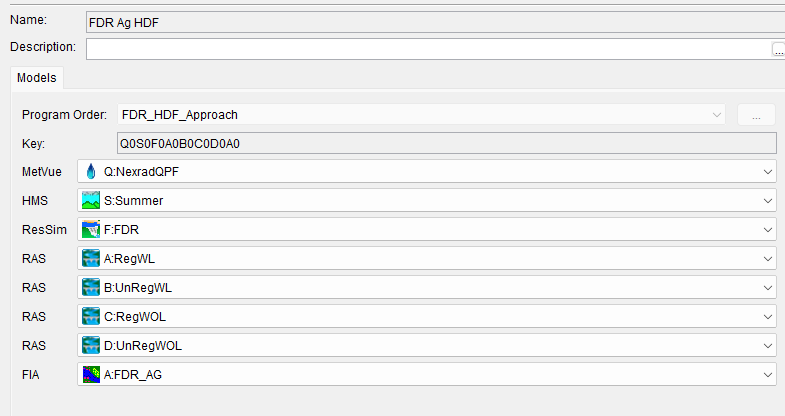HEC-FIA Holdout RAS HDF Compute
A recent enhancement to HEC-FIA is the Holdout RAS HDF Compute, which allows HEC-FIA to process four distinct HEC-RAS output HDF files as inputs. This advanced method offers several key benefits over the traditional HEC-FIA Holdouts approach:
- Improved Without-Levee Damage Calculations: By using HEC-RAS unsteady hydraulics, the Holdout RAS HDF Compute provides a more accurate representation of flood damage compared to the assumptions used in the classic HEC-FIA method.
- Better Control Over Damage Allocation: This approach offers greater flexibility in determining how benefits are distributed between levees and reservoirs.
- Comprehensive FDR Calculations: It enables the calculation of flood damages reduced for both agricultural areas and structures.
This method is particularly useful for watersheds with large levee systems, those with multiple reservoirs where the impacts extend beyond district boundaries, and those that need to account for agricultural flood damage reduction.
When to Use the Holdout RAS HDF Compute
In this context, "large levees" refers to levee systems that have a significant hydraulic impact on river stages when comparing "with-levee" vs. "without-levee" scenarios. If the hydraulic impact of the levees is large enough, the simplified assumptions used in the HEC-FIA Holdouts approach for "without levee" scenarios may not be appropriate.
For more guidance on selecting the right method for the "without-levee" scenario, see the section Selecting a Without-Levee Modeling Approach.
Required HEC-RAS Model Alternatives
To calculate FDR for systems with both reservoirs and levees using this approach, the process starts by running four separate HEC-RAS scenarios. These scenarios require two different HEC-RAS geometries: one for "with-levee" and another for "without-levee" conditions.
The four required scenarios are:
- Regulated (Observed) Condition: With both reservoirs and levees in place.
- Unregulated Condition: Without reservoirs, but with levees in place.
- Regulated without Levee: With reservoirs but without levees.
- Unregulated without Levee: No reservoirs and no levees.
The Holdout RAS HDF Compute can also be applied to watersheds with only reservoirs (no levees). For more details on this, refer to the relevant tutorial.
How It Works
During the CAVI forecast, HEC-FIA computes reservoir allocation percentages using the holdout methodology. You can choose how to allocate portions of levee benefits across reservoirs. This process is discussed in more detail in the section Analyzing Consequence Results.
Forecast Run
The flow of data through the models is similar to a standard CWMS real-time forecast through HEC-ResSim. After this, four different HEC-RAS simulations are needed, corresponding to the four scenarios mentioned earlier. These results are then passed to the HEC-FIA Holdout RAS HDF alternative to compute FDR and allocate benefits accordingly.

The figure below shows an example forecast run for this methodology.

Model Alternatives
Beyond the standard CWMS setup, three additional HEC-RAS alternatives are required to represent the necessary hydraulic scenarios. For detailed instructions on setting up these alternatives, refer to the HEC-RAS Model Setup section. This method uses the HEC-FIA Holdout RAS HDF configuration, so a new HEC-FIA alternative must be created.